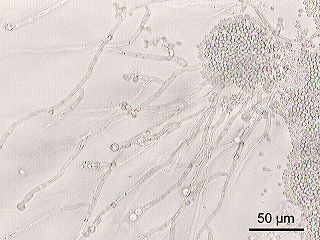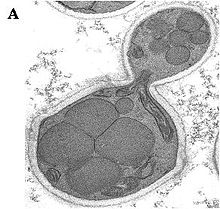
Yeasts are eukaryotic, single-celled microorganisms classified as members of the fungus kingdom. The first yeast originated hundreds of millions of years ago, and at least 1,500 species are currently recognized. They are estimated to constitute 1% of all described fungal species.
Methylotrophs are a diverse group of microorganisms that can use reduced one-carbon compounds, such as methanol or methane, as the carbon source for their growth; and multi-carbon compounds that contain no carbon-carbon bonds, such as dimethyl ether and dimethylamine. This group of microorganisms also includes those capable of assimilating reduced one-carbon compounds by way of carbon dioxide using the ribulose bisphosphate pathway. These organisms should not be confused with methanogens which on the contrary produce methane as a by-product from various one-carbon compounds such as carbon dioxide. Some methylotrophs can degrade the greenhouse gas methane, and in this case they are called methanotrophs. The abundance, purity, and low price of methanol compared to commonly used sugars make methylotrophs competent organisms for production of amino acids, vitamins, recombinant proteins, single-cell proteins, co-enzymes and cytochromes.

Torulaspora delbrueckii is a ubiquitous yeast species with both wild and anthropic habitats. The type strain of T. delbrueckii is CBS 1146T, equivalent to CLIB 230 or ATCC 10662, etc.. The type strain of T. delbrueckii CBS 1146 T was sequenced in 2009, and is composed of 8 chromosomes in addition to a mitochondrial genome.

Saccharomycetales belongs to the kingdom of Fungi and the division Ascomycota. It is the only order in the class Saccharomycetes. There are currently 13 families recognized as belonging to Saccharomycetales. GBIF also includes; Alloascoideaceae, Eremotheciaceae (16) Trigonopsidaceae and Wickerhamomycetaceae.

Saccharomycotina is a subdivision (subphylum) of the division (phylum) Ascomycota in the kingdom Fungi. It comprises most of the ascomycete yeasts. The members of Saccharomycotina reproduce by budding and they do not produce ascocarps.
Pichia is a genus of yeasts in the family Pichiaceae with spherical, elliptical, or oblong acuminate cells. Pichia is a teleomorph, and forms hat-shaped, hemispherical, or round ascospores during sexual reproduction. The anamorphs of some Pichia species are Candida species. The asexual reproduction is by multilateral budding.

Kluyveromyces marxianus in ascomycetous yeast and member of the genus, Kluyveromyces. It is the sexual stage of Atelosaccharomyces pseudotropicalis also known as Candida kefyr. This species has a homothallic mating system and is often isolated from dairy products.

Schizosaccharomyces is a genus of fission yeasts. The most well-studied species is S. pombe. At present five Schizosaccharomyces species have been described. Like the distantly related Saccharomyces cerevisiae, S. pombe is a significant model organism in the study of eukaryotic cell biology. It is particularly useful in evolutionary studies because it is thought to have diverged from the Saccharomyces cerevisiae lineage between 300 million and 1 billion years ago, and thus provides an evolutionarily distant comparison.

Ogataea polymorpha is a methylotrophic yeast with unusual characteristics. It is used as a protein factory for pharmaceuticals.
The Pichiaceae are a family of yeasts in the order Saccharomycetales. According to the 2007 Outline of Ascomycota, the family contains four genera, but GBIF lists 15 genera. The family was named by Zender in 1925.
Yarrowia is a fungal genus in the family Dipodascaceae. For a while the genus was monotypic, containing the single species Yarrowia lipolytica, a yeast that can use unusual carbon sources, such as hydrocarbons. This has made it of interest for use in industrial microbiology, especially for the production of specialty lipids. Molecular phylogenetics analysis has revealed several other species that have since been added to the genus.
Nakazawaea is a genus of yeast in the order Saccharomycetales. The relationship of this taxon to other taxa within the order is not fully unknown.
Sporobolomyces is a fungal genus of uncertain familial placement in the order Sporidiobolales. Species in the genus are anamorphic yeasts. Teleomorphic forms are included in the genus Sporidiobolus. Generic synonyms of Sporobolomyces include Amphiernia Grüss (1927), and Prosporobolomyces E.K.Novák & Zsolt (1961), and Ballistosporomyces Nakase, G.Okada & Sugiy. (1989). Sporobolomyces species produce ballistoconidia that are bilaterally symmetrical, they have Coenzyme Q10 or Coenzyme Q10(H2) as their major ubiquinone, they lack xylose in whole-cell hydrolysates, and they cannot ferment sugars.
Kuraishia is a genus of two species of ascomycetous yeasts in the family Saccharomycetaceae. The type species Kuraishia capsulata was originally described as a member of Hansenula in 1953.
Saitoella is a genus of two species of yeast in the family Protomycetaceae. The type species, Saitoella complicata, originally isolated from Himalayan soil, had its genome sequenced. The genus is named after professor Kendo Saito for his contributions to the taxonomy of the genus Rhodotorula. A second species, Saitoella coloradoensis, isolated from insect frass found on Engelmann spruce in Colorado, was described as new in 2012.
Blastobotrys elegans is a species of fungus.
Pseudotremella is a genus of fungi in the family Bulleraceae. All Pseudotremella species are parasites of other fungi and produce anamorphic yeast states. Basidiocarps, when produced, are gelatinous and are colloquially classed among the "jelly fungi". Four species of Pseudotremella are currently recognized worldwide. Two of these species are, as yet, only known from their yeast states.
The Phaffomycetaceae are a family of yeasts in the order Saccharomycetales that reproduce by budding. Species in the family have a widespread distribution.
The Wickerhamomycetaceae are a family of yeasts in the order Saccharomycetales that reproduce by budding. Species in the family have a widespread distribution.
Wickerhamomyces is a genus of fungi within the Saccharomycetales order. It is placed within the familyof Phaffomycetaceae.






